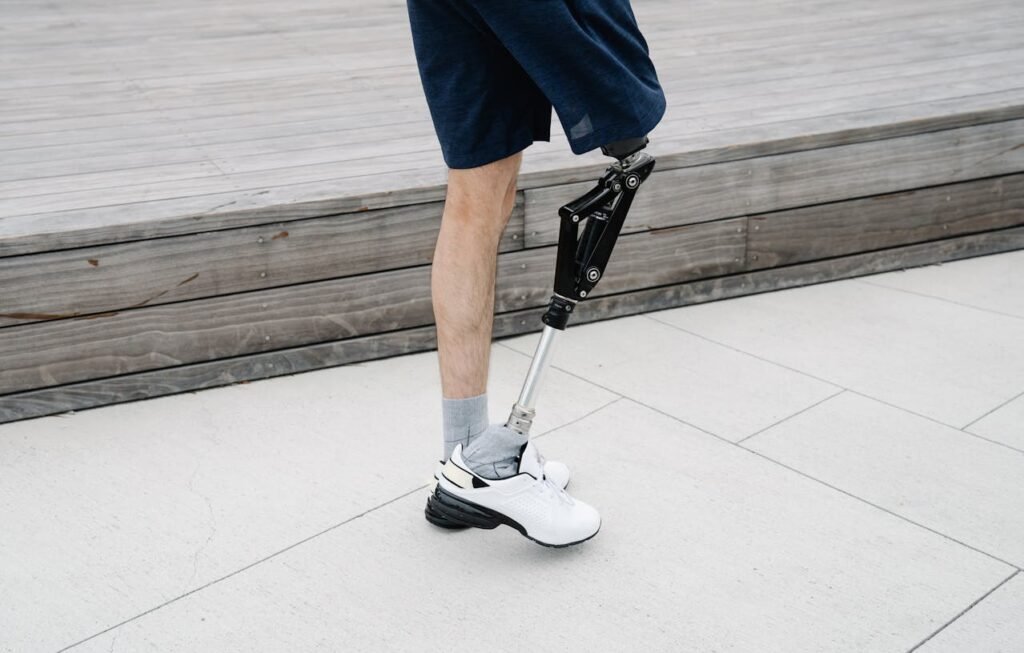Growing older doesn’t mean giving up strength. In fact, it’s the opposite. Staying strong helps you move with ease, keep balance, and live with confidence. For seniors using prosthetic knees or feet, gentle strength training is one of the best ways to feel steady and secure again.
At RoboBionics, we’ve seen firsthand how the right movements can change lives. Seniors who once hesitated to walk or stand find freedom again through simple, safe exercises designed just for them. You don’t need a gym or fancy equipment—just a few minutes, a sturdy chair, and a little patience.
This guide walks you through easy, proven strength moves that help your legs, hips, and core support your prosthesis better. The steps are clear, the tone is calm, and every move is made for real people—people who want to move with dignity, strength, and ease.
Why Strength Training Matters for Seniors with Prosthetics
The Power of Strength in Everyday Life
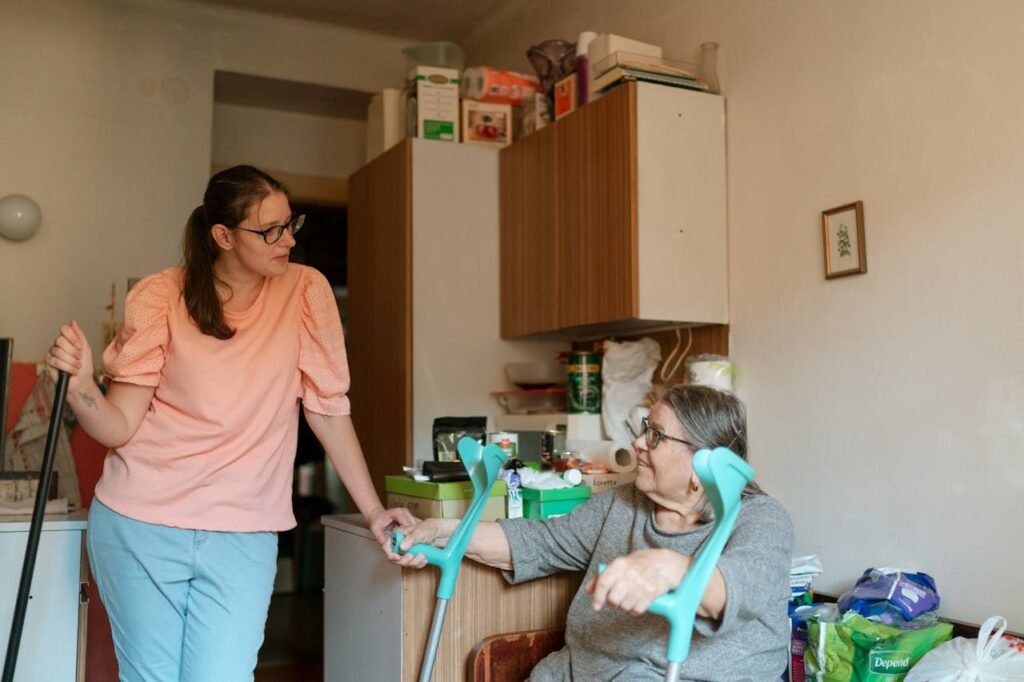
Strength is not just about muscles—it’s about freedom. When your legs and core are strong, simple things like standing, walking, or climbing a step feel easier.
For seniors with prosthetic knees or feet, muscle power supports stability and balance. It helps your prosthesis move naturally, reducing strain on the rest of your body.
Even small improvements in strength can transform how you move each day. Tasks that once felt tiring become smoother, lighter, and more enjoyable.
How Strength Protects Your Joints and Prosthesis
A prosthesis does amazing work, but your body still needs to share the effort. Strong muscles absorb pressure before it reaches your joints or your prosthetic connection.
When your thighs, hips, and calves do their part, your knees and residual limb stay comfortable. This also reduces the wear on your prosthetic parts, keeping them working efficiently for longer.
Strength training is not just about fitness—it’s smart care for your body and your device.
The Confidence Connection
Strength brings confidence. Each time you practice a movement and feel it become easier, your trust in your prosthesis grows.
That confidence spills into every part of life—walking outdoors, meeting friends, even standing a little taller. The stronger you feel, the more independent you become.
At RoboBionics, we’ve seen many seniors rediscover joy in motion through strength building. It starts small, but it changes everything.
Preparing Safely Before You Begin
Setting Up Your Space
Find a calm, open area where you can move freely. A sturdy chair or wall nearby gives support when needed.
Avoid slippery floors or rugs that might slide. If you can, exercise near natural light—it keeps your energy up and mood positive.
Keep your prosthesis properly fitted and secure. If something feels loose or tight, adjust it before starting. Comfort is key to safe movement.
Warm-Up for Gentle Motion
Warming up wakes up your muscles and prepares your joints. It also helps your body adjust to your prosthesis before strength work begins.
Start with a few minutes of slow marching in place. Swing your arms gently and take steady breaths.
Then move your ankles and knees in light circles, and roll your shoulders a few times. These small movements open up your body, reducing stiffness.
A good warm-up is like a friendly handshake with your body—it tells it that it’s time to move.
Listening to Your Body
Every person moves differently, and that’s okay. If something feels uncomfortable, pause. Adjust your position, breathe deeply, and continue when ready.
Mild stretching or gentle tension is normal, but sharp pain is not. Never force a movement.
Take breaks when needed, sip water, and go at your own pace. Strength grows through patience, not pressure.
Building Strength in the Legs
Seated Leg Lifts
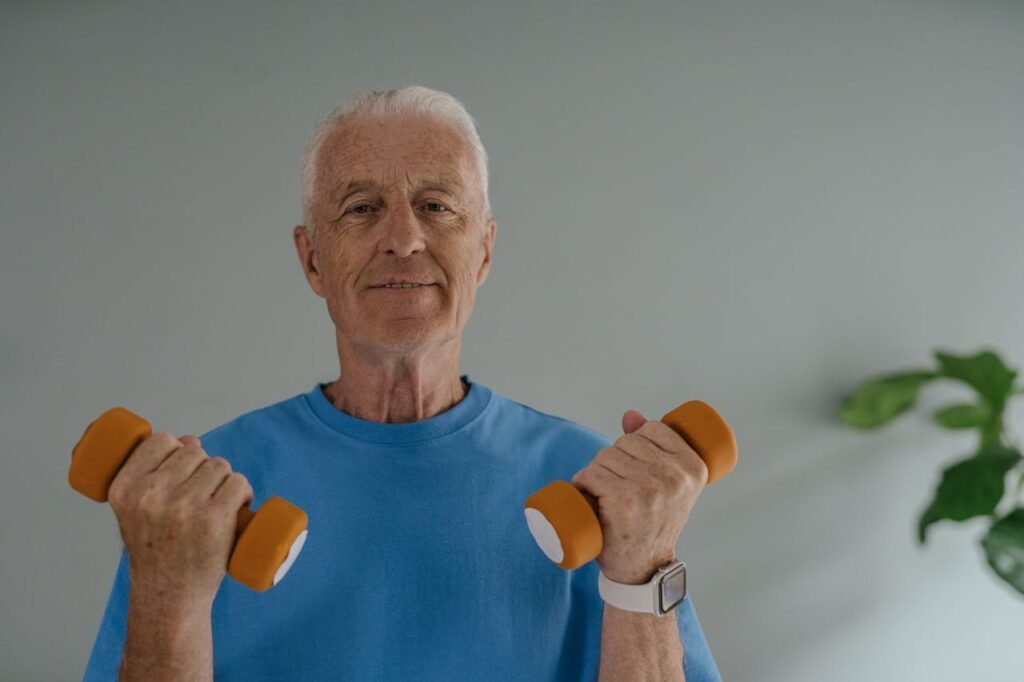
Sit tall in a sturdy chair with both feet flat on the ground. Slowly lift your prosthetic leg until it’s straight, hold for a few seconds, then lower it.
Do the same with your sound leg. Move slowly and focus on control.
This strengthens your thighs and helps your prosthetic knee or ankle move smoothly during walking. It also improves coordination between both legs.
Supported Squats
Stand behind your chair and hold the backrest for balance. Slowly bend your knees as if sitting down, keeping your chest lifted. Then return to standing.
You don’t have to go deep—just enough to feel your thigh muscles working.
These squats build power in your legs and hips, making standing and walking easier. Over time, they improve balance and reduce the effort needed to move with your prosthesis.
Gentle Step-Throughs
Using a stable surface for support, step your sound leg forward slightly, then bring your prosthetic leg to meet it. Step back again and repeat.
This exercise mimics natural walking and strengthens the muscles you use with every stride. It also helps train smoother transitions between your prosthetic and sound leg.
If needed, start with shorter steps and build distance slowly. Each small movement improves rhythm and strength.
Calf Strengtheners
Stand with your hands on a wall or chair. Raise yourself onto your toes, hold briefly, then lower your heels slowly.
This simple move strengthens your calves and ankles, which are vital for smooth walking and balance.
If you have a prosthetic foot, do the exercise using both legs together to maintain equal support. It builds joint stability and reduces fatigue when walking longer distances.
Engaging the Hips and Core
Hip Sways for Balance
Stand tall and gently shift your weight from one hip to the other. Keep your shoulders relaxed and your knees soft.
This motion strengthens your hip stabilizers and improves side-to-side balance, especially useful when turning or standing for long periods.
Try it near a wall or counter for support at first. As you improve, you’ll feel more control through your hips and waist.
Seated Core Activations
Sit upright with your hands resting lightly on your thighs. Draw your belly in slightly as you breathe out, then relax as you breathe in.
This small but powerful movement activates your core—the center of your balance.
Practicing this daily strengthens your lower back and abdominal muscles, helping you stay upright and steady while walking or standing.
Hip Extensions for Stability
Hold a stable surface, like a wall or table, and gently move your prosthetic leg backward while keeping your torso still. Return slowly to your starting position.
This move strengthens the glute muscles, which support your hips and lower back. Strong glutes help absorb impact and keep your body balanced during walking.
If your prosthesis feels tight while extending, keep the motion small but steady. Over time, flexibility improves naturally.
Core Twists
Sit or stand comfortably with your hands on your shoulders. Rotate your upper body gently from side to side, keeping your hips still.
This strengthens your oblique muscles—the ones that help your body stay stable when you change direction.
It also improves flexibility through the spine and reduces stiffness after long sitting or walking sessions.
Strength Moves for the Knees and Ankles
Seated Knee Extensions
Sit tall with your back supported and feet flat. Lift one foot, straighten your knee, hold for two seconds, and slowly lower it.
Alternate between your sound leg and prosthetic side. Even if your prosthetic knee doesn’t bend, moving your natural leg helps maintain balance and coordination.
This exercise strengthens your thigh muscles, which protect both knees and improve walking endurance.
Ankle Flex and Point
If your prosthetic allows ankle movement, gently flex your toes toward you and then point them away. For the sound leg, do the same to keep both sides equally strong.
These small movements keep your ankles flexible and improve circulation in your legs.
If your prosthetic foot is fixed, simply visualize the motion and move your hips slightly to simulate it. Mental focus still activates supporting muscles.
Mini Lunges for Control
Stand with one hand on a wall or chair. Step your sound leg slightly forward and bend both knees a little. Return to standing and switch sides.
This exercise builds strength around your knees and hips. It also teaches you to control weight shifts safely—key for smooth prosthetic movement.
Keep your steps short and steady. Over time, you’ll notice better control when walking or climbing steps.
Heel Presses
While seated, press your prosthetic heel gently into the floor, hold for a few seconds, then relax. Do the same with your sound heel.
This small action strengthens your hamstrings and builds stability around your knees.
It also helps your prosthesis respond better when you transfer weight while standing or walking.
Building Upper Body Support for Balance
Arm Pushes for Posture
Sit tall, place your hands on the sides of your chair, and press down gently as if lifting yourself slightly. Hold for two seconds, then relax.
This strengthens your shoulders, triceps, and chest muscles, helping you maintain good posture and balance when walking with a prosthesis.
A strong upper body also helps you use canes or railings safely when needed.
Shoulder Rolls for Flexibility
Relax your arms at your sides and roll your shoulders slowly backward, then forward. Breathe deeply as you move.
Shoulder mobility affects your whole posture. When your shoulders are free, your spine aligns better, which improves balance while walking.
You can do this anytime—morning, evening, or before sleep—to release tension.
Wall Press Strengthener
Stand facing a wall, place your palms on it at shoulder height, and lean forward slowly as if doing a gentle push-up. Then push back to standing.
This move strengthens your chest, arms, and core muscles. These are the same muscles that help you steady yourself during turns or uneven terrain.
A few slow repetitions each day improve control and confidence in your upper body.
Progressing Safely to Advanced Strength Moves
Building Strength Step by Step
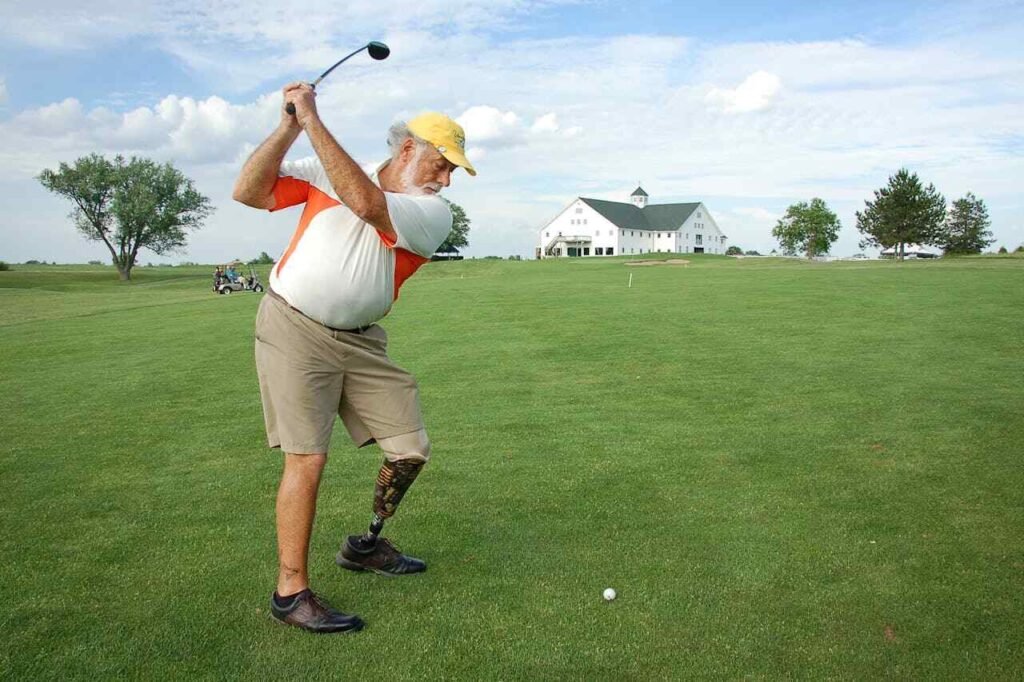
Once the basic moves feel easy, it’s time to take them a little further. Progression doesn’t mean heavier workouts—it means slightly more control, smoother coordination, and better posture.
Increase repetitions slowly or hold each movement for a few seconds longer. The goal is to challenge your muscles just enough to grow stronger without causing fatigue or discomfort.
If a movement ever feels too hard or unsteady, take a step back and return to what feels comfortable. Small, consistent progress creates lasting results.
Standing Leg Lifts for Control
Stand behind a chair or countertop for support. Gently lift your prosthetic leg to the side, keeping your toes forward and your body upright. Lower it slowly, then repeat with your sound leg.
This exercise strengthens your hip abductors—the muscles that help keep your hips level and your gait smooth.
If balance feels tricky, keep both hands on the chair. As you gain confidence, you can try it with one hand or none at all.
Seated Resistance Press
If you have a resistance band or towel, loop it around the ball of your sound foot. Hold the ends firmly and press your foot forward slowly, then return to start.
This builds strength in your thighs and calves without standing. It also improves control in your prosthetic limb, as both sides learn to share effort equally.
If you don’t have a band, pressing gently into the floor with your foot can still engage the same muscles.
Assisted Sit-to-Stands
This move bridges the gap between sitting and standing—one of the most important motions for independence.
Sit toward the edge of your chair with feet flat. Lean forward slightly, press through your legs, and rise to stand using your thighs, not just your arms. Hold for a moment, then lower yourself slowly.
Use your hands for light support if needed. Over time, aim to use less arm help. This strengthens your quads, hips, and balance control in a practical, everyday way.
Controlled Step-Ups
Find a low step or sturdy block. Hold a railing or wall for support. Step up with your sound leg, bring your prosthetic leg up beside it, then step back down slowly.
Keep your movements deliberate and steady. This exercise strengthens your legs and teaches proper coordination for stairs or uneven terrain.
As your confidence grows, you can practice on slightly higher steps. Always prioritize safety over speed.
Improving Balance and Coordination
The Role of Balance in Strength
Balance is what turns strength into stability. You might have strong muscles, but without coordination, movement still feels uncertain.
Balance training teaches your brain and body to work together—to sense position, adjust quickly, and trust your prosthesis.
Even a few minutes of balance work each day can dramatically improve your walking confidence and reaction speed.
Single-Leg Weight Transfers
Stand with your feet hip-width apart and a chair in front of you. Shift your weight gently toward your prosthetic side without lifting your other foot. Hold for a few seconds, then move the weight to your sound side.
This exercise builds awareness and control in your hips and legs. It teaches your body how to distribute weight evenly—a skill that reduces limping and fatigue.
Start small, focusing on smooth transitions. Over time, balance becomes instinctive.
Side Reaches for Stability
Stand with your feet comfortably apart and one hand resting on a stable surface. Slowly reach your other arm to the side while keeping your body upright.
This movement trains your core and balance muscles to react naturally. It also strengthens your coordination between upper and lower body.
Alternate sides for a few repetitions. Try moving your gaze along with your arm—it adds an extra challenge for your balance.
Gentle Heel-to-Toe Walk
Find a clear space or wall for support. Place one foot directly in front of the other so your heel touches your toes.
Walk slowly in a straight line, focusing on balance and posture. Keep your head up and your eyes forward.
This simple drill sharpens coordination, improves gait control, and builds ankle strength. It’s especially helpful for prosthetic foot users learning smoother steps.
Using a Cushion for Balance
For an advanced but safe challenge, stand on a firm cushion or folded towel while holding onto a counter or chair.
Shift your weight gently side to side, keeping your posture straight. The uneven surface activates deeper stabilizing muscles that support your joints and prosthesis.
Do this for just a few minutes daily—it’s a small exercise with powerful results for coordination and confidence.
Making Strength Training Part of Daily Life
Integrating Movement Naturally
The best exercise is the one you do regularly. You don’t need a special session every day—many strength moves fit easily into daily routines.
Stand on one leg while brushing your teeth, do a few seated leg lifts while watching TV, or perform gentle stretches before bed.
When movement becomes part of your everyday rhythm, it stops feeling like “exercise” and starts feeling like natural living.
Using Household Objects for Support
Chairs, walls, and countertops make perfect training partners. Use them for light balance support while doing squats or hip movements.
Even household items like water bottles can serve as light weights for upper body strengthening. The key is consistency, not equipment.
Movement should always feel accessible, not complicated.
Walking as a Strength Exercise
Walking itself is a gentle yet powerful strength move. It builds endurance in your legs, hips, and core while improving cardiovascular health.
Start with short, steady walks in familiar areas. Focus on posture and rhythm rather than speed. As your body adapts, increase your distance gradually.
Walking daily also helps your prosthetic limb stay in sync with your natural movements. It’s simple, effective, and endlessly beneficial.
Turning Chores into Strength Training
Everyday activities can double as exercises. Rising from a chair, bending to pick something up, or standing at the counter all strengthen muscles naturally.
Think of these as mini training moments. Moving mindfully during chores—keeping posture tall and steps controlled—adds up over time.
Small efforts made daily build lasting strength and resilience.
Safety and Recovery Practices
Prioritizing Comfort and Control
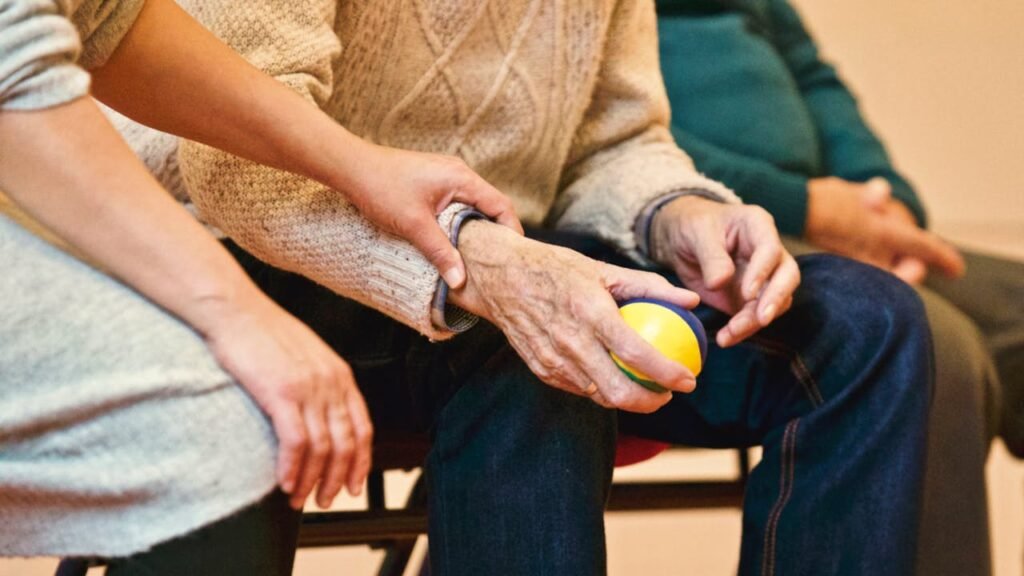
Your safety always comes first. Every movement should feel steady, not rushed.
Check your prosthesis fit before starting any exercise. A loose socket or worn liner can cause friction or discomfort.
If you ever feel pain or unusual pressure, stop and rest. Adjust or seek help before continuing. Consistency matters only when paired with comfort.
Managing Fatigue Wisely
Tired muscles are natural after exercise, but excessive fatigue means you’ve done too much.
Start small and listen to your body. Alternate between strength days and rest days. Short breaks during sessions keep your energy steady and prevent soreness.
Remember, rest builds strength just as much as exercise does.
Cooling Down for Relaxation
After your session, spend a few minutes cooling down. Gentle stretches or slow seated breathing help your body relax and recover.
Stretch your calves, hamstrings, and back gently. Move slowly and breathe deeply. This prevents stiffness and helps circulation return to normal.
Cooling down is the quiet part of strength building—the moment your body thanks you for your effort.
Staying Hydrated and Nourished
Strong muscles need fuel. Drink water before and after your exercises to stay hydrated.
Eat balanced meals with protein, fruits, and vegetables to support recovery. Proper nutrition keeps your energy up and helps your muscles rebuild.
Your body and prosthesis work as a team—fueling them well keeps both running smoothly.
Long-Term Strength and Independence
Tracking Your Progress
Write down what you do each day—how many repetitions, how you felt, and what improved.
Even small notes help you see progress over time. Maybe you stood a little longer, walked a little farther, or needed less support.
Those quiet victories remind you that your work is paying off. Strength builds slowly, but it always builds.
Staying Connected to Professionals
Regular check-ins with your prosthetist and physiotherapist keep you on track. They can adjust your prosthesis alignment or update your exercise plan as your strength grows.
If something feels off—like new discomfort or unusual strain—don’t ignore it. Professional guidance keeps your progress safe and steady.
You’re never alone in your journey; your care team is part of your success.
Keeping Motivation Alive
Motivation comes and goes, but habits stay. On days when you feel tired, remind yourself of why you started—to move freely, to live confidently, to stay independent.
Put on some light music, move slowly, and enjoy the process. The effort itself is a form of self-care.
When you move with purpose, strength follows naturally.
Celebrating the Freedom of Movement
Strength is more than muscle—it’s peace of mind. It’s being able to stand with ease, walk to the garden, or hug someone without hesitation.
At RoboBionics, we design prosthetic knees and feet that move in harmony with your body—so your effort pays off in comfort and control.
Our technology, paired with your determination, can bring back the simple joys of everyday movement. To experience how a well-designed prosthesis can enhance your life, you can schedule a demo with us at robobionics.in/bookdemo.
Keep moving, keep growing stronger, and trust your body—it’s capable of more than you think.



